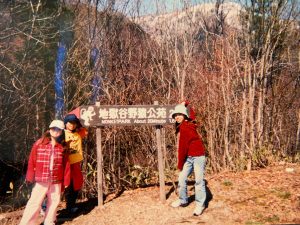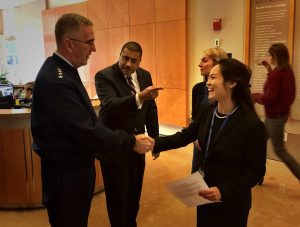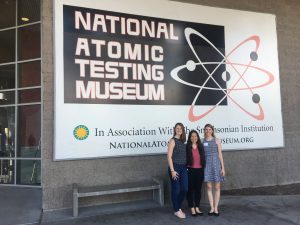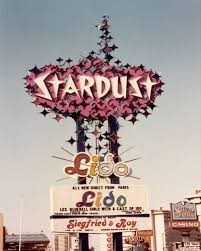The Atomic City: Learning About Home From Afar
When I was younger, amongst my various bucket hats and boat caps, I used to wear a white baseball cap that said “Stardust Hotel and Casino” on it. I never thought twice about that hat until this past year.

Ariel, front left wearing white Stardust baseball cap, and her family in her father’s hometown in Japan on their way to the Jigokundai Monkey Park.
I was born and raised in Las Vegas, Nevada. Growing up, I vaguely understood that Nevada was home to many nuclear weapons tests and that either Yucca Mountain should not be in my backyard or something should not be in Yucca Mountain and that had something to do with my backyard. But beyond that, even when I studied Nevada history in school, nuclear weapons and waste were rarely, if ever, discussed.
It wasn’t until I left for college that I learned more about U.S. nuclear policy and its inextricable link to my home state. To fulfill a degree requirement, I happened to take a class entitled “A Global History of the Atomic Age” – I was completely stunned by how little I knew about an issue that was so close to home. As North Korea conducted nuclear weapons tests, nuclear policy became a hot-button issue. These tests along with renewed concerns regarding nuclear waste storage led me to wonder what role, if any, Nevadans had on the national stage. What if the U.S. decided, in response to North Korean testing, to resume atmospheric and/or underground testing — where would that testing occur? Following Senator Harry Reid’s retirement and the end of the Obama administration, renewed debate over waste storage seemed almost inevitable – but where would that waste go? In light of these questions, I was inspired to bring a nonpartisan educational opportunity back to Las Vegas.
As a Herbert Scoville Jr. Peace Fellow, I was given an incredible opportunity: to pursue my passions for nine months. I am incredibly indebted to this organization for both supporting my ideas and connecting me to the right people to make them a reality. As a Scoville Fellow at the Brookings Institution, I provided research assistance to Brookings Senior Fellows and ran events with government officials on issues related to the future of arms control and extended deterrence in East Asia. But most importantly, I had the opportunity to work with Senior Fellows Frank Rose and Robert Einhorn and Scoville Alumnae Kate Hewitt and Maggie Tennis.

Ariel, Scoville ’17 Maggie Tennis, and Frank Rose welcoming General John Hyten to the Brookings Institution.
While I knew I would be working with Kate, I didn’t know that she and her colleague Erin Connolly had created a project focused on public education in Washington state the year prior. It was the perfect collision. Kate and Erin had laid the groundwork, and with the financial support from Brookings and support for Erin from the Center for Arms Control and Nonproliferation, we hit the ground running.
In May 2019 Erin, Maggie, and I traveled to Las Vegas where we had organized a day-long seminar and four days of lectures to teach students about U.S. nuclear weapons and waste policy. The seminar, hosted at the National Atomic Testing Museum, brought together 50 high school and college students representing 12 different schools across Southern Nevada. The day consisted of lectures, break-out sessions, and a wargame and featured guest speakers Mark Martinez, the Director of the Nevada National Security Site, and Thomas Hunter, the former Director of Sandia National Labs. And while the seminar started with students quietly sitting in their seats, it ended with cohorts of negotiators scattered across the lecture hall debating economic sanctions and the Comprehensive Test Ban Treaty to resolve world tensions during our North Korea nuclear negotiation simulation.
The rest of the trip was spent at my alma mater, Green Valley High School. Over four days of lecture, of which Maggie and Erin joined for one and two days respectively, I met with 650 students: they ranged in age from freshmen to seniors, and in course-level from Regular to International Baccalaureate. With 4 distinct presentations, I gave an additional 16 lectures, and ran 3 more wargames. The opportunity to go back to my high school was incredibly rewarding. My time teaching in Vegas reinforced three lessons. First, increasing diversity in the nuclear field requires expanding educational outreach. Second, nuclear policy is complex but can be accessible if taught appropriately. And third, we have a responsibility to share our knowledge to the incoming generation of global citizens.
At the end of the week, however, a more intimate lesson struck me. One of our guest speakers tangentially asked if I remembered the Stardust Hotel, and instantly I was taken back to my bedazzled, sparkly white baseball cap. But, rather than reminisce on my 10-year-old fashion choices, I recognized what I had missed long ago: the Stardust logo. It was built in the image of an atomic cloud, a nod to the years Las Vegas capitalized on the spectacle of nuclear testing, calling itself, “Atomic City.” And suddenly, I realized just how personal the work of this fellowship became to me.
Ariel Higuchi was a Fall 2018 Scoville Fellow at the Brookings Institution.


